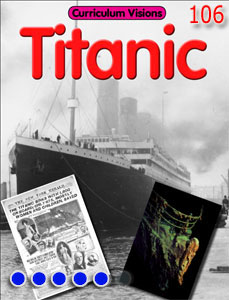The Titanic was one of the Olympic Class ocean liners (there were three: the Titanic, the Olympic and the Britannic). Olympic and Titanic were built side by side. Britannic was built later.
Each ship was about 46,000 tonnes, 880 ft (270 m)long, with engines producing 59,0000 horsepower. They could cruise at about 21 knots (39 km/h; 24 mph) and could carry just over 3,000 passengers and crew. There were 840 cabins: first class: 416; second class: 162; third class: 262. In today’s money the ships cost about £100 million each.
They were not the fastest because the owners wanted them to be the biggest and most luxurious instead. They used three propellers and had four funnels. The fourth was actually a dummy which was used for ventilation purposes. Four funnels was considered to be the most up to date at the time.
There was room along the deckside for 60 lifeboats, although only 20 were installed as it was felt that too many lifeboats would clutter the view. The shipbuilders thought of their huge vessels as the ultimate lifeboats and no other lifeboats were really needed except, perhaps, if the engines failed and people had to be ferried to rescue boats. Nevertheless, the Olympic boats still carried more lifeboats than regulations at the time required. So they were regarded as being in excess of safety requirements. So no expense was spared on safety: Titanic was designed by experienced engineers, using some of the most advanced technologies and safety features of the time.
There were many other safety features on board. For example, there were two steam-powered steering engines, but only one was kept in use; the other one was kept in reserve. The steel plate used for Titanic’s hull was nearly 1½ inch (nearly 4 cm) thick.
It was calm weather and a perfect crossing. Everyone was having a fabulous time – until Sunday, April 14 at 23:40. At this time, Titanic struck an iceberg at 41°46’N 50°14’W while steaming about 400 miles south of the Grand Banks of Newfoundland.
The vessel was at full cruising speed and the enormous impact caused many of the rivets that held the hull plates together to pop out. This caused a leak in the hull below the waterline. A collision had been foreseen and designed for. The ship was built with many watertight compartments in case of such a problem. In fact, it had been designed so that, even with four compartments flooded, it could stay afloat. But the collision was so great that it flooded five, and eventually seven compartments. So this is why the ship gradually sank. It sank 2 hours and 40 minutes later in perfectly calm seas with a loss of 1,517 lives.




